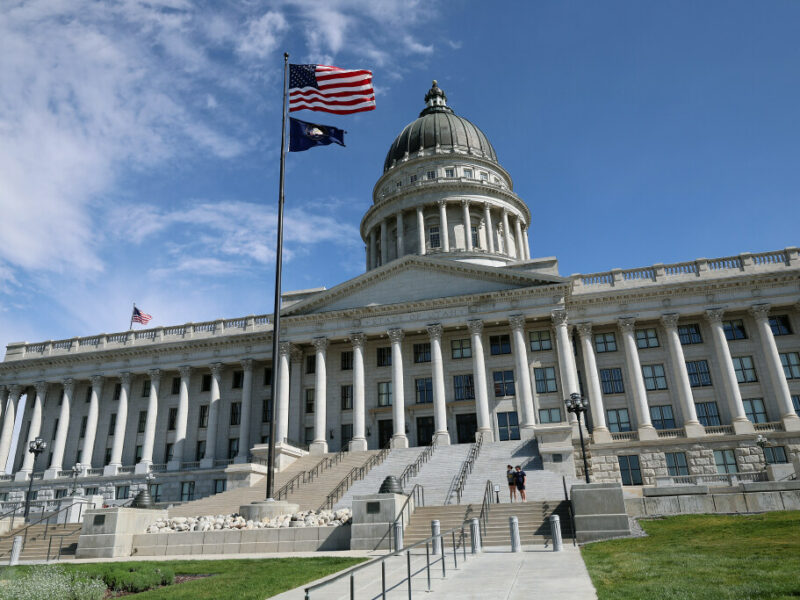
Blanding and Torrey are among the next “Zoom towns” in Utah

During the pandemic, many people got a new lease on life—and new leases.
Almost 3 million people in the United States permanently relocated during the first year of the pandemic. According to the Bureau of Labor Statistics, the pandemic also caused over one-third of businesses to increase telework opportunities for employees. Utah is in the top five states with the highest percentage of remote workers nationwide.
Many of these relocations were to “gateway communities,” a term coined for regions near public land, national parks, and resort communities. In Utah, the most popular places to relocate are areas like Moab and Springdale.
Since the start of the pandemic, these gateway communities have seen record numbers of new construction, both from tourism and relocation. This boom brought about both money and dynamism, things communities benefit from.
But Danya Rumore, director and research professor at the Environmental Dispute Resolution Program at the University of Utah, says it’s not all good. She’s concerned about the future of the rural locations colonized by remote workers, referring to them as “Zoom towns.”
“It’s a neat and tidy term to talk about what’s happening,” Rumore says, “But the things we’re facing—it’s bigger than a catchy phrase.”
In 2015, Rumore and a team of researchers joined forces with locals in the region of Zion’s National Park to try and reduce “severe congestion.”
“A drastic increase in visitation led to overcrowding, housing shortages, and a suite of related issues,” she says. “I spent about three years intimately involved in the facilitation of collaboratives there, trying to ease the stress the growth boom caused.”
Rumore is from Sandpoint, Idaho, another gateway community in the western region. As she worked in Zion, Rumore and her team watched her hometown and others like Aspen, Colorado, and Joshua Tree, California document similar issues.
“The issues we studied in Zion are all traditional challenges for a gateway community to face,” she says. “Back then, we expected these negative trends to progressively worsen there and in communities like it over the next 15 years. And we have seen that 15-year change in one year.”
The Aspens of the west
When the pandemic hit, relocating remote workers begat more aggressive speculative buying, which begat overall commodification of gateway communities in Utah and across the western United States. All the above drove housing costs up and pushed locals out, and well-established gateway communities went from feeling the heat to hitting their melting points.
“In Aspen, the housing prices went from $350,000 to over $600,000 in one year, while the local per capita income stayed at $20,000."
“In Aspen, the housing prices went from $350,000 to over $600,000 in one year, while the local per capita income stayed at $20,000,” Rumore says. “Aspen had a system in place to manage population fluctuations, and they’re scrambling again to find a new system that will work.”
Of course, the Aspen example is one of the “better” situations playing out in towns with resources at their fingertips. For Utah’s “Zoom towns,” that’s not the case.
“Moab doesn’t have a property tax. They don’t have revenue streams that are proportionally appropriate for the challenges they’re facing,” Rumore says. “The costs springing up from the intense growth aren’t something they can face head-on with set-aside money. It’s problematic.”
To handle the sudden growth, gateway communities need long-term plans—ones like Aspen had. But thinking ahead is harder than it seems.
Ch-ch-ch-changes
“There are a lot of communities in our pool that you’ve never heard of,” Rumore says. “These are places the general populous wouldn’t necessarily automatically label as a ‘gateway,’ even though they’re proximate to high-quality natural amenities.”
Here’s how it happens: You want to move to Jackson Hole, Wyoming, but you waited too long. Now the building prices have skyrocketed, and everything’s built out. Instead, you look to the surrounding areas and ask, “Where else can I do fun things?”
“That’s when the smaller, surrounding towns come into the mix,” Rumore says. “The property is cheaper, but the amenities are just as great—you can ski and bike, and now you can be the first person to open a coffee shop or a brew pub. Now that community has a ‘cool factor’ that starts attracting more people. Suddenly, it’s on the development trajectory.”
This cycle has hit lots of small towns across the western United States. In Utah, Rumore and her team have identified both Blanding and Torrey as those next in line.
“Torrey had a population in the hundreds,” Rumore says. “Blanding is in the thousands. They’re not busy, bustling city centers. Both are on the docket now because the original spots have become so overwhelmed.”
But the thing is, most of these smaller communities want to stay small.
“I would call what we’re seeing ‘community trauma,’ where these conflicts over the growth are getting so personal. We’re seeing deep grief that, unfortunately, is being turned into anger.”
“These debates crop up: ‘Stop the growth’ versus ‘don’t stop the growth,’” Rumore says. “And we have to say, I’m sorry, but that’s just not a productive conversation. We don’t have a tool in our toolkit to stop the growth. What we should be talking about is protecting the quality of life—that’s what we might be able to manage.”
Unfortunately, these up-and-comers aren’t even having the unproductive types of debates yet.
“‘Planning’ is a bad word in some of our locations,” Rumore says. “Government intervention is a problem. Local community planning doesn’t get much pushback, but when we get into the county and state, it becomes an argument of private property rights and developments.”
It’s also a case of, “if I can’t see you, you can’t see me,” Rumore says. “A lot of people think this can’t happen to them. That’s to be avoided at all costs for a lot of these folks. But whether or not we talk about it, these lifestyle-altering changes happen overnight.”
Once the floodgates open, Rumore says there’s not much you can do to stop the bleeding. A community’s strength lies in prevention.
“You don’t have to court growth,” she says. “But if you’re a gateway community or even near one, you have to be ready for it.”
And the “growth” Rumore is referring to isn’t just people moving in across the street.
“That’s another misstep some communities are making: not thinking of all the possibilities,” she says. “Growth could come through tourism. It could be people buying properties and turning them into short-term rentals.”
The sudden conversion of Springdale, Utah is an example Rumore and her team point to.
“They were accustomed to having a very vibrant and small downtown with galleries and restaurants,” she says. “It was a definitive part of their identity. In the last year, so much pressure rose for transient lodging that galleries were converted into overnight rentals.”
Rumore says Springdale was in the early stages of building out a plan and they were still blindsided.
“They’re losing local businesses to lodging for newcomers and tourists,” she says. “And now they’re scrambling to create policies and regulations that could stop their downtown from being entirely converted into lodging.”
A catch-22
Sometimes, efforts to improve the locals’ lives can expedite growth even further.
“We’re seeing that with broadband initiatives,” Rumore says. “Two things happen simultaneously: your kids can use Zoom, but so can the people who want to move into your town.”
Her words of advice? “If you’re going to expand broadband, you’d better be ready for what comes with it.”
Communities know to expect that money and demographics change with growth, but Rumore says there’s a darker side to the situation as well.
“I would call what we’re seeing ‘community trauma,’ where these conflicts over the growth are getting so personal,” she says. “We’re seeing deep grief that, unfortunately, is being turned into anger.”
That anger, while Rumore thinks it may be misplaced, is fair.
“We’re hearing from Jackson, Wyoming that they’re worried about rich people flying their own employees in with them, eliminating the need for local employees,” Rumore says. “And I don’t think they’re alarmists. I think they, and the rest of these gateway communities, have great reason to worry.”
So how can Rumore and her team get to these communities to get planning underway and preventative measures in place before it’s too late? The answer is the gateway and natural amenity region (GNAR) initiative.
“We’re trying to tell the story of communities that have struggled and are currently struggling with the severe problems caused by rapid growth,” Rumore says. “We’re hearing a lot of, ‘I wish we started planning for this 20 years ago,’ and we want to prevent this for the towns we see next on the growth crest.”
Rumore says data is one thing, but when local leaders and communities hear the narratives of their neighbors, they start listening.
“Stories get to us in a way that numbers can’t,” she says. “When we paint the circumstances in this way, ‘Here’s what folks in Moab, Springdale, Aspen, or Jackson Hole are feeling about their situation,’ I think it sparks more action.”
Rumore has started the process through an online toolkit, initiating peer-to-peer conversations and the biggest push: case studies.
“I come at all of my work from a collaboration perspective,” she says. “At its heart, the challenge of this migration comes in getting people to work together to protect the things that make these places special.”
But in a swirl of good intentions and no common enemy, Rumore says the academics and locals engaged in this work have a tough road ahead of them.
“It’s a tragedy of the commons,” she says. “I don’t fault people for wanting to live in these beautiful places, and I don’t fault the locals for wanting to maintain their current way of life. Nobody here means to cause harm, but the thing is, collectively, we’re causing a lot.” ![]()





